Clinical Leadership in Nursing: Analysis of Leadership Theories
VerifiedAdded on 2021/10/29
|10
|2459
|83
Essay
AI Summary
This paper provides a comprehensive analysis of clinical leadership in nursing, addressing its significance in contemporary healthcare settings. The introduction highlights the challenges in modern hospital care, emphasizing the importance of effective clinical leadership for ensuring high-quality, safe, and effective patient care. The paper critically analyzes four articles by Mannix, Wilkes, and Daly (2013), Hutchinson and Jackson (2013), Martin et al. (2012), and Dignam et al. (2012), focusing on leadership theories, research findings, limitations, and recommendations. The analysis reveals the prominence of transformational leadership theory in promoting a healthy workplace environment and improving patient outcomes. The paper also touches upon collaborative and transactional leadership approaches. The conclusion reinforces the indispensable role of clinical leadership in nursing, the importance of effective communication, and the need for leadership training to optimize clinical leadership in practice, while also acknowledging the limitations of the studies and recommending further research.
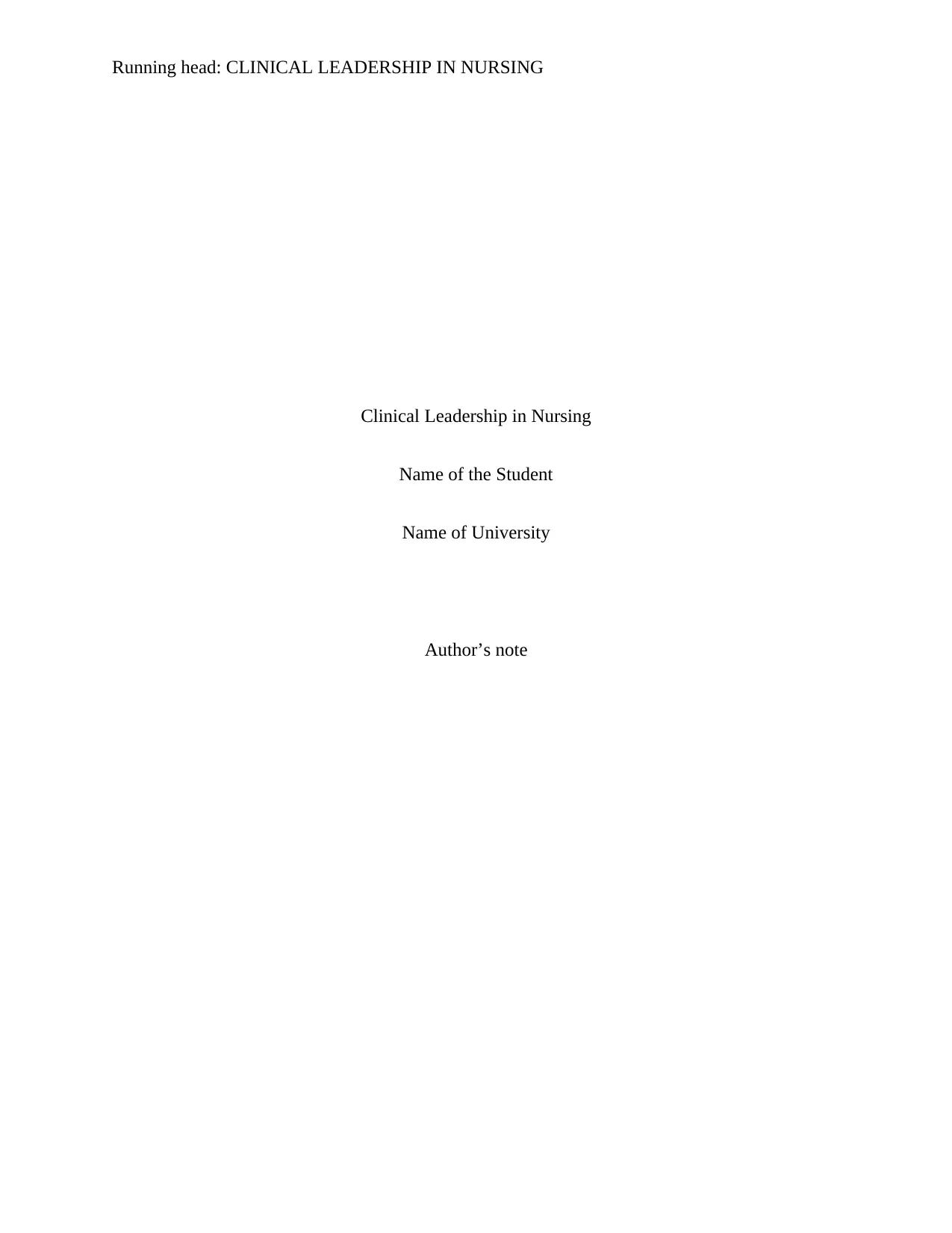
Running head: CLINICAL LEADERSHIP IN NURSING
Clinical Leadership in Nursing
Name of the Student
Name of University
Author’s note
Clinical Leadership in Nursing
Name of the Student
Name of University
Author’s note
Paraphrase This Document
Need a fresh take? Get an instant paraphrase of this document with our AI Paraphraser
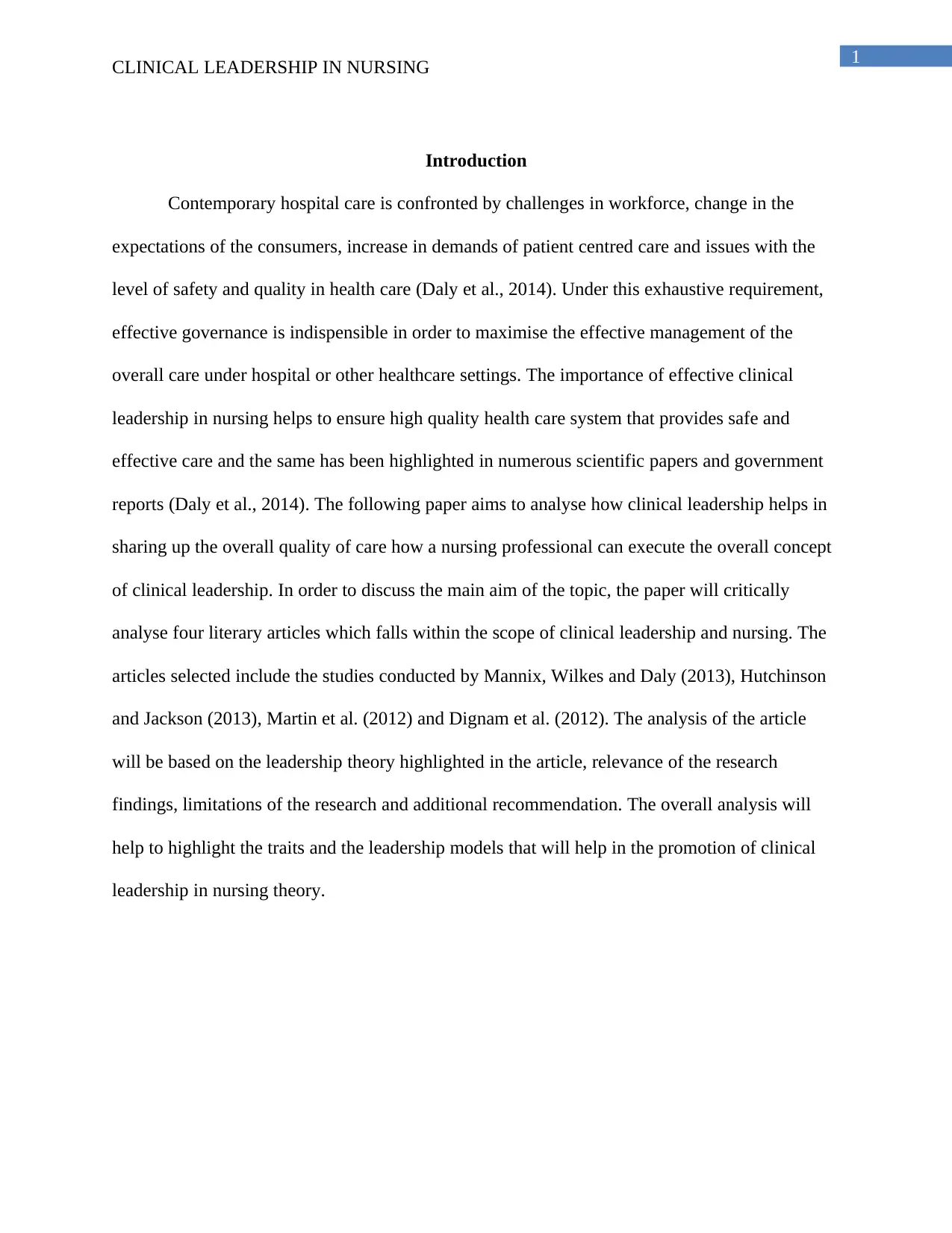
1
CLINICAL LEADERSHIP IN NURSING
Introduction
Contemporary hospital care is confronted by challenges in workforce, change in the
expectations of the consumers, increase in demands of patient centred care and issues with the
level of safety and quality in health care (Daly et al., 2014). Under this exhaustive requirement,
effective governance is indispensible in order to maximise the effective management of the
overall care under hospital or other healthcare settings. The importance of effective clinical
leadership in nursing helps to ensure high quality health care system that provides safe and
effective care and the same has been highlighted in numerous scientific papers and government
reports (Daly et al., 2014). The following paper aims to analyse how clinical leadership helps in
sharing up the overall quality of care how a nursing professional can execute the overall concept
of clinical leadership. In order to discuss the main aim of the topic, the paper will critically
analyse four literary articles which falls within the scope of clinical leadership and nursing. The
articles selected include the studies conducted by Mannix, Wilkes and Daly (2013), Hutchinson
and Jackson (2013), Martin et al. (2012) and Dignam et al. (2012). The analysis of the article
will be based on the leadership theory highlighted in the article, relevance of the research
findings, limitations of the research and additional recommendation. The overall analysis will
help to highlight the traits and the leadership models that will help in the promotion of clinical
leadership in nursing theory.
CLINICAL LEADERSHIP IN NURSING
Introduction
Contemporary hospital care is confronted by challenges in workforce, change in the
expectations of the consumers, increase in demands of patient centred care and issues with the
level of safety and quality in health care (Daly et al., 2014). Under this exhaustive requirement,
effective governance is indispensible in order to maximise the effective management of the
overall care under hospital or other healthcare settings. The importance of effective clinical
leadership in nursing helps to ensure high quality health care system that provides safe and
effective care and the same has been highlighted in numerous scientific papers and government
reports (Daly et al., 2014). The following paper aims to analyse how clinical leadership helps in
sharing up the overall quality of care how a nursing professional can execute the overall concept
of clinical leadership. In order to discuss the main aim of the topic, the paper will critically
analyse four literary articles which falls within the scope of clinical leadership and nursing. The
articles selected include the studies conducted by Mannix, Wilkes and Daly (2013), Hutchinson
and Jackson (2013), Martin et al. (2012) and Dignam et al. (2012). The analysis of the article
will be based on the leadership theory highlighted in the article, relevance of the research
findings, limitations of the research and additional recommendation. The overall analysis will
help to highlight the traits and the leadership models that will help in the promotion of clinical
leadership in nursing theory.
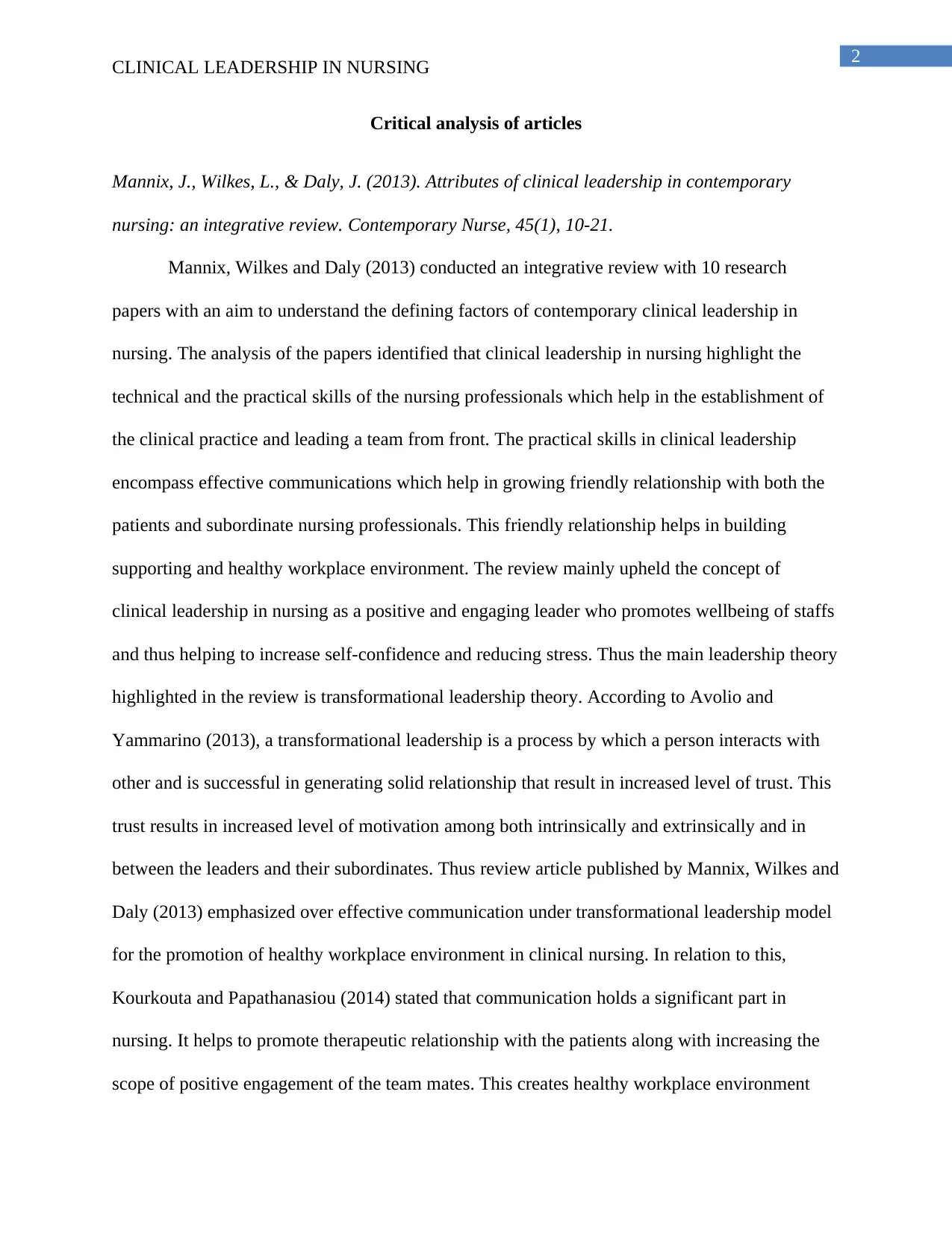
2
CLINICAL LEADERSHIP IN NURSING
Critical analysis of articles
Mannix, J., Wilkes, L., & Daly, J. (2013). Attributes of clinical leadership in contemporary
nursing: an integrative review. Contemporary Nurse, 45(1), 10-21.
Mannix, Wilkes and Daly (2013) conducted an integrative review with 10 research
papers with an aim to understand the defining factors of contemporary clinical leadership in
nursing. The analysis of the papers identified that clinical leadership in nursing highlight the
technical and the practical skills of the nursing professionals which help in the establishment of
the clinical practice and leading a team from front. The practical skills in clinical leadership
encompass effective communications which help in growing friendly relationship with both the
patients and subordinate nursing professionals. This friendly relationship helps in building
supporting and healthy workplace environment. The review mainly upheld the concept of
clinical leadership in nursing as a positive and engaging leader who promotes wellbeing of staffs
and thus helping to increase self-confidence and reducing stress. Thus the main leadership theory
highlighted in the review is transformational leadership theory. According to Avolio and
Yammarino (2013), a transformational leadership is a process by which a person interacts with
other and is successful in generating solid relationship that result in increased level of trust. This
trust results in increased level of motivation among both intrinsically and extrinsically and in
between the leaders and their subordinates. Thus review article published by Mannix, Wilkes and
Daly (2013) emphasized over effective communication under transformational leadership model
for the promotion of healthy workplace environment in clinical nursing. In relation to this,
Kourkouta and Papathanasiou (2014) stated that communication holds a significant part in
nursing. It helps to promote therapeutic relationship with the patients along with increasing the
scope of positive engagement of the team mates. This creates healthy workplace environment
CLINICAL LEADERSHIP IN NURSING
Critical analysis of articles
Mannix, J., Wilkes, L., & Daly, J. (2013). Attributes of clinical leadership in contemporary
nursing: an integrative review. Contemporary Nurse, 45(1), 10-21.
Mannix, Wilkes and Daly (2013) conducted an integrative review with 10 research
papers with an aim to understand the defining factors of contemporary clinical leadership in
nursing. The analysis of the papers identified that clinical leadership in nursing highlight the
technical and the practical skills of the nursing professionals which help in the establishment of
the clinical practice and leading a team from front. The practical skills in clinical leadership
encompass effective communications which help in growing friendly relationship with both the
patients and subordinate nursing professionals. This friendly relationship helps in building
supporting and healthy workplace environment. The review mainly upheld the concept of
clinical leadership in nursing as a positive and engaging leader who promotes wellbeing of staffs
and thus helping to increase self-confidence and reducing stress. Thus the main leadership theory
highlighted in the review is transformational leadership theory. According to Avolio and
Yammarino (2013), a transformational leadership is a process by which a person interacts with
other and is successful in generating solid relationship that result in increased level of trust. This
trust results in increased level of motivation among both intrinsically and extrinsically and in
between the leaders and their subordinates. Thus review article published by Mannix, Wilkes and
Daly (2013) emphasized over effective communication under transformational leadership model
for the promotion of healthy workplace environment in clinical nursing. In relation to this,
Kourkouta and Papathanasiou (2014) stated that communication holds a significant part in
nursing. It helps to promote therapeutic relationship with the patients along with increasing the
scope of positive engagement of the team mates. This creates healthy workplace environment
⊘ This is a preview!⊘
Do you want full access?
Subscribe today to unlock all pages.

Trusted by 1+ million students worldwide
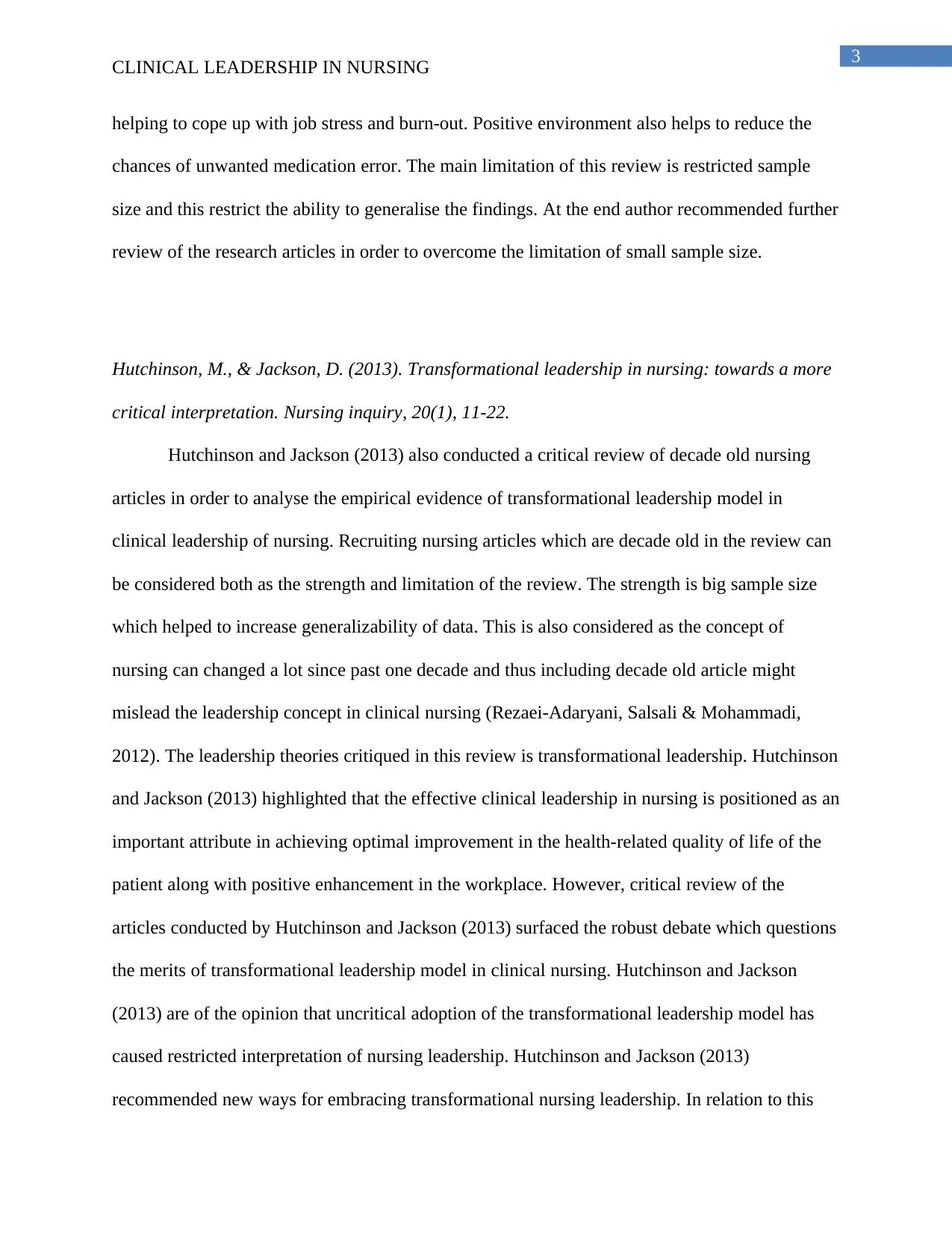
3
CLINICAL LEADERSHIP IN NURSING
helping to cope up with job stress and burn-out. Positive environment also helps to reduce the
chances of unwanted medication error. The main limitation of this review is restricted sample
size and this restrict the ability to generalise the findings. At the end author recommended further
review of the research articles in order to overcome the limitation of small sample size.
Hutchinson, M., & Jackson, D. (2013). Transformational leadership in nursing: towards a more
critical interpretation. Nursing inquiry, 20(1), 11-22.
Hutchinson and Jackson (2013) also conducted a critical review of decade old nursing
articles in order to analyse the empirical evidence of transformational leadership model in
clinical leadership of nursing. Recruiting nursing articles which are decade old in the review can
be considered both as the strength and limitation of the review. The strength is big sample size
which helped to increase generalizability of data. This is also considered as the concept of
nursing can changed a lot since past one decade and thus including decade old article might
mislead the leadership concept in clinical nursing (Rezaei-Adaryani, Salsali & Mohammadi,
2012). The leadership theories critiqued in this review is transformational leadership. Hutchinson
and Jackson (2013) highlighted that the effective clinical leadership in nursing is positioned as an
important attribute in achieving optimal improvement in the health-related quality of life of the
patient along with positive enhancement in the workplace. However, critical review of the
articles conducted by Hutchinson and Jackson (2013) surfaced the robust debate which questions
the merits of transformational leadership model in clinical nursing. Hutchinson and Jackson
(2013) are of the opinion that uncritical adoption of the transformational leadership model has
caused restricted interpretation of nursing leadership. Hutchinson and Jackson (2013)
recommended new ways for embracing transformational nursing leadership. In relation to this
CLINICAL LEADERSHIP IN NURSING
helping to cope up with job stress and burn-out. Positive environment also helps to reduce the
chances of unwanted medication error. The main limitation of this review is restricted sample
size and this restrict the ability to generalise the findings. At the end author recommended further
review of the research articles in order to overcome the limitation of small sample size.
Hutchinson, M., & Jackson, D. (2013). Transformational leadership in nursing: towards a more
critical interpretation. Nursing inquiry, 20(1), 11-22.
Hutchinson and Jackson (2013) also conducted a critical review of decade old nursing
articles in order to analyse the empirical evidence of transformational leadership model in
clinical leadership of nursing. Recruiting nursing articles which are decade old in the review can
be considered both as the strength and limitation of the review. The strength is big sample size
which helped to increase generalizability of data. This is also considered as the concept of
nursing can changed a lot since past one decade and thus including decade old article might
mislead the leadership concept in clinical nursing (Rezaei-Adaryani, Salsali & Mohammadi,
2012). The leadership theories critiqued in this review is transformational leadership. Hutchinson
and Jackson (2013) highlighted that the effective clinical leadership in nursing is positioned as an
important attribute in achieving optimal improvement in the health-related quality of life of the
patient along with positive enhancement in the workplace. However, critical review of the
articles conducted by Hutchinson and Jackson (2013) surfaced the robust debate which questions
the merits of transformational leadership model in clinical nursing. Hutchinson and Jackson
(2013) are of the opinion that uncritical adoption of the transformational leadership model has
caused restricted interpretation of nursing leadership. Hutchinson and Jackson (2013)
recommended new ways for embracing transformational nursing leadership. In relation to this
Paraphrase This Document
Need a fresh take? Get an instant paraphrase of this document with our AI Paraphraser
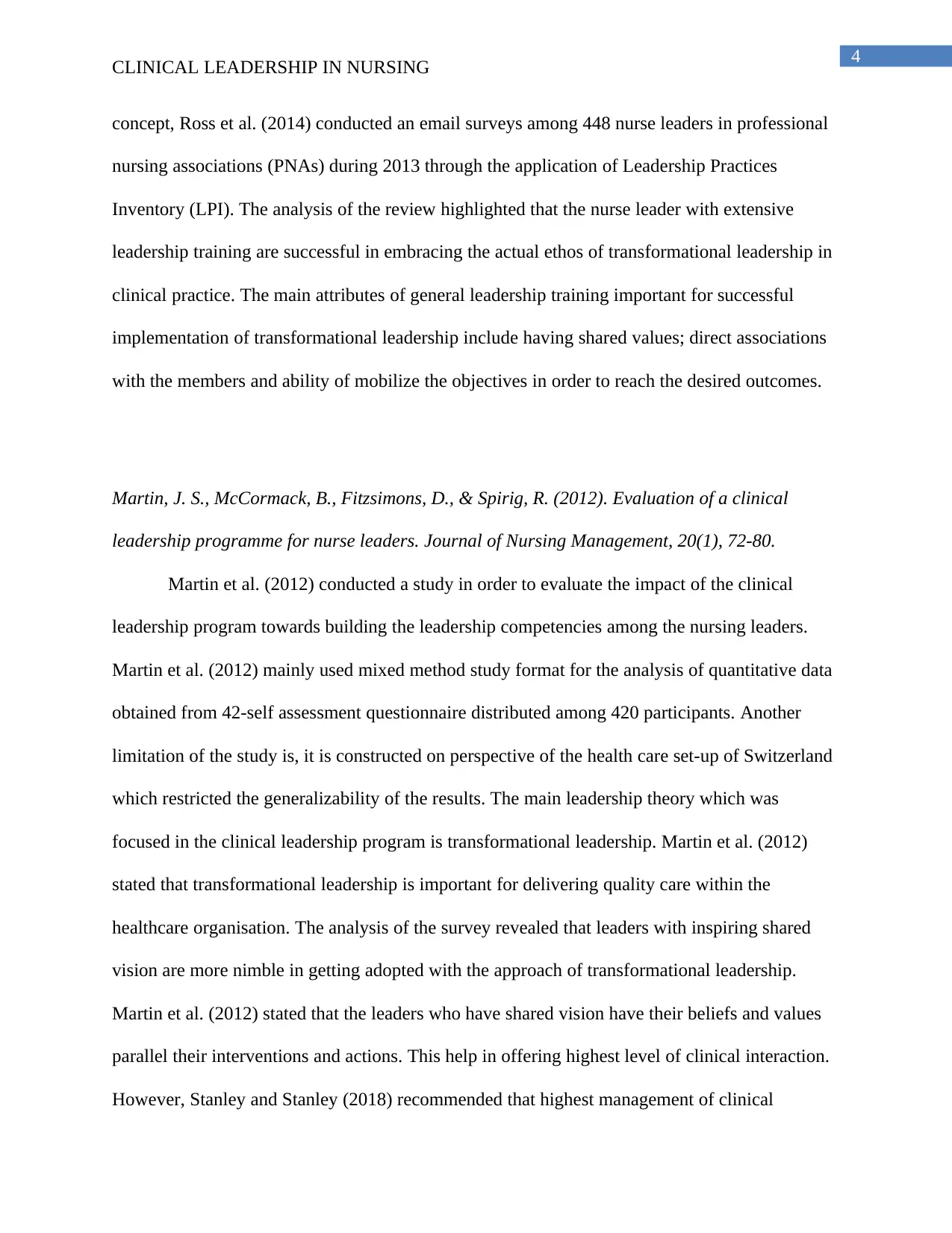
4
CLINICAL LEADERSHIP IN NURSING
concept, Ross et al. (2014) conducted an email surveys among 448 nurse leaders in professional
nursing associations (PNAs) during 2013 through the application of Leadership Practices
Inventory (LPI). The analysis of the review highlighted that the nurse leader with extensive
leadership training are successful in embracing the actual ethos of transformational leadership in
clinical practice. The main attributes of general leadership training important for successful
implementation of transformational leadership include having shared values; direct associations
with the members and ability of mobilize the objectives in order to reach the desired outcomes.
Martin, J. S., McCormack, B., Fitzsimons, D., & Spirig, R. (2012). Evaluation of a clinical
leadership programme for nurse leaders. Journal of Nursing Management, 20(1), 72-80.
Martin et al. (2012) conducted a study in order to evaluate the impact of the clinical
leadership program towards building the leadership competencies among the nursing leaders.
Martin et al. (2012) mainly used mixed method study format for the analysis of quantitative data
obtained from 42-self assessment questionnaire distributed among 420 participants. Another
limitation of the study is, it is constructed on perspective of the health care set-up of Switzerland
which restricted the generalizability of the results. The main leadership theory which was
focused in the clinical leadership program is transformational leadership. Martin et al. (2012)
stated that transformational leadership is important for delivering quality care within the
healthcare organisation. The analysis of the survey revealed that leaders with inspiring shared
vision are more nimble in getting adopted with the approach of transformational leadership.
Martin et al. (2012) stated that the leaders who have shared vision have their beliefs and values
parallel their interventions and actions. This help in offering highest level of clinical interaction.
However, Stanley and Stanley (2018) recommended that highest management of clinical
CLINICAL LEADERSHIP IN NURSING
concept, Ross et al. (2014) conducted an email surveys among 448 nurse leaders in professional
nursing associations (PNAs) during 2013 through the application of Leadership Practices
Inventory (LPI). The analysis of the review highlighted that the nurse leader with extensive
leadership training are successful in embracing the actual ethos of transformational leadership in
clinical practice. The main attributes of general leadership training important for successful
implementation of transformational leadership include having shared values; direct associations
with the members and ability of mobilize the objectives in order to reach the desired outcomes.
Martin, J. S., McCormack, B., Fitzsimons, D., & Spirig, R. (2012). Evaluation of a clinical
leadership programme for nurse leaders. Journal of Nursing Management, 20(1), 72-80.
Martin et al. (2012) conducted a study in order to evaluate the impact of the clinical
leadership program towards building the leadership competencies among the nursing leaders.
Martin et al. (2012) mainly used mixed method study format for the analysis of quantitative data
obtained from 42-self assessment questionnaire distributed among 420 participants. Another
limitation of the study is, it is constructed on perspective of the health care set-up of Switzerland
which restricted the generalizability of the results. The main leadership theory which was
focused in the clinical leadership program is transformational leadership. Martin et al. (2012)
stated that transformational leadership is important for delivering quality care within the
healthcare organisation. The analysis of the survey revealed that leaders with inspiring shared
vision are more nimble in getting adopted with the approach of transformational leadership.
Martin et al. (2012) stated that the leaders who have shared vision have their beliefs and values
parallel their interventions and actions. This help in offering highest level of clinical interaction.
However, Stanley and Stanley (2018) recommended that highest management of clinical
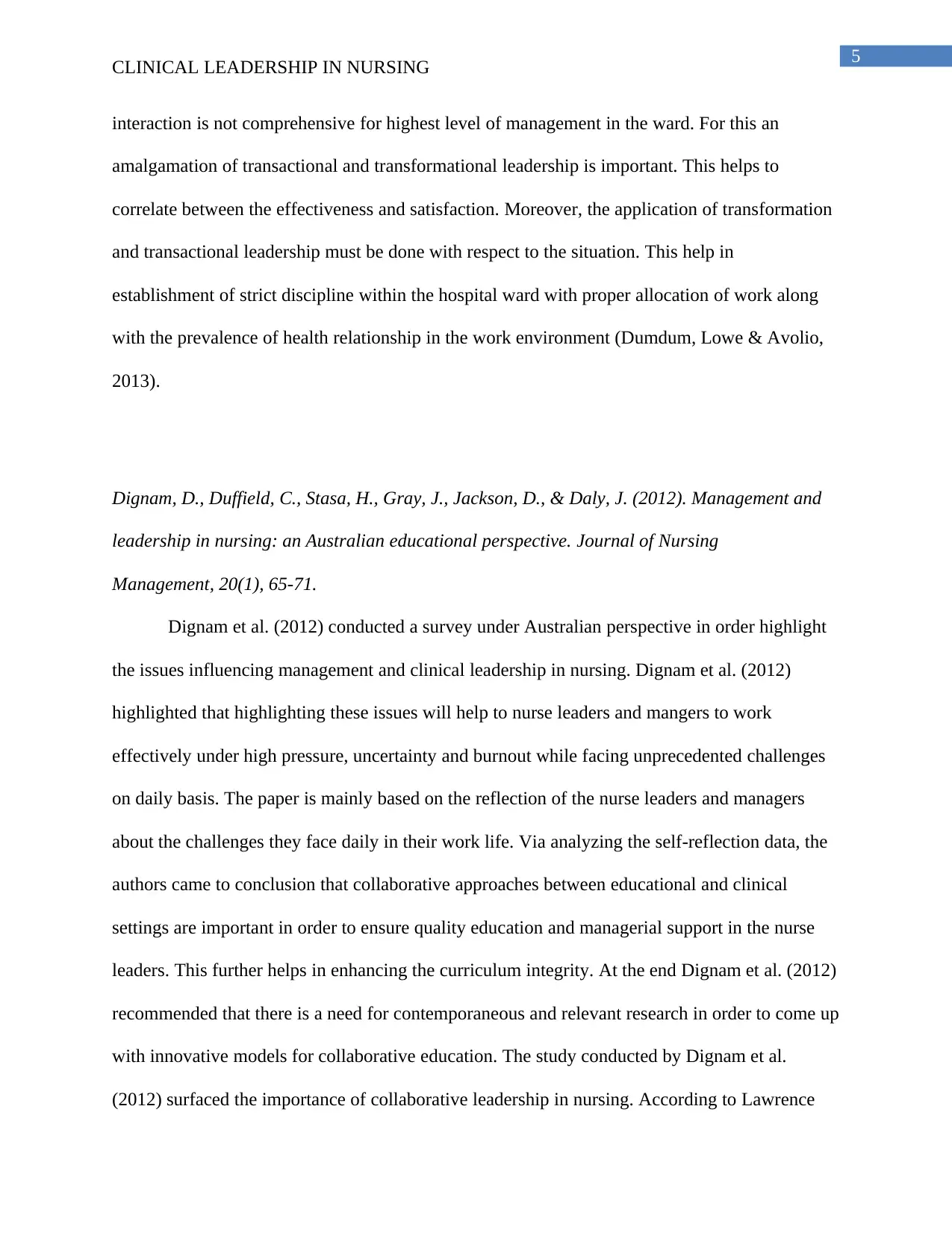
5
CLINICAL LEADERSHIP IN NURSING
interaction is not comprehensive for highest level of management in the ward. For this an
amalgamation of transactional and transformational leadership is important. This helps to
correlate between the effectiveness and satisfaction. Moreover, the application of transformation
and transactional leadership must be done with respect to the situation. This help in
establishment of strict discipline within the hospital ward with proper allocation of work along
with the prevalence of health relationship in the work environment (Dumdum, Lowe & Avolio,
2013).
Dignam, D., Duffield, C., Stasa, H., Gray, J., Jackson, D., & Daly, J. (2012). Management and
leadership in nursing: an Australian educational perspective. Journal of Nursing
Management, 20(1), 65-71.
Dignam et al. (2012) conducted a survey under Australian perspective in order highlight
the issues influencing management and clinical leadership in nursing. Dignam et al. (2012)
highlighted that highlighting these issues will help to nurse leaders and mangers to work
effectively under high pressure, uncertainty and burnout while facing unprecedented challenges
on daily basis. The paper is mainly based on the reflection of the nurse leaders and managers
about the challenges they face daily in their work life. Via analyzing the self-reflection data, the
authors came to conclusion that collaborative approaches between educational and clinical
settings are important in order to ensure quality education and managerial support in the nurse
leaders. This further helps in enhancing the curriculum integrity. At the end Dignam et al. (2012)
recommended that there is a need for contemporaneous and relevant research in order to come up
with innovative models for collaborative education. The study conducted by Dignam et al.
(2012) surfaced the importance of collaborative leadership in nursing. According to Lawrence
CLINICAL LEADERSHIP IN NURSING
interaction is not comprehensive for highest level of management in the ward. For this an
amalgamation of transactional and transformational leadership is important. This helps to
correlate between the effectiveness and satisfaction. Moreover, the application of transformation
and transactional leadership must be done with respect to the situation. This help in
establishment of strict discipline within the hospital ward with proper allocation of work along
with the prevalence of health relationship in the work environment (Dumdum, Lowe & Avolio,
2013).
Dignam, D., Duffield, C., Stasa, H., Gray, J., Jackson, D., & Daly, J. (2012). Management and
leadership in nursing: an Australian educational perspective. Journal of Nursing
Management, 20(1), 65-71.
Dignam et al. (2012) conducted a survey under Australian perspective in order highlight
the issues influencing management and clinical leadership in nursing. Dignam et al. (2012)
highlighted that highlighting these issues will help to nurse leaders and mangers to work
effectively under high pressure, uncertainty and burnout while facing unprecedented challenges
on daily basis. The paper is mainly based on the reflection of the nurse leaders and managers
about the challenges they face daily in their work life. Via analyzing the self-reflection data, the
authors came to conclusion that collaborative approaches between educational and clinical
settings are important in order to ensure quality education and managerial support in the nurse
leaders. This further helps in enhancing the curriculum integrity. At the end Dignam et al. (2012)
recommended that there is a need for contemporaneous and relevant research in order to come up
with innovative models for collaborative education. The study conducted by Dignam et al.
(2012) surfaced the importance of collaborative leadership in nursing. According to Lawrence
⊘ This is a preview!⊘
Do you want full access?
Subscribe today to unlock all pages.

Trusted by 1+ million students worldwide
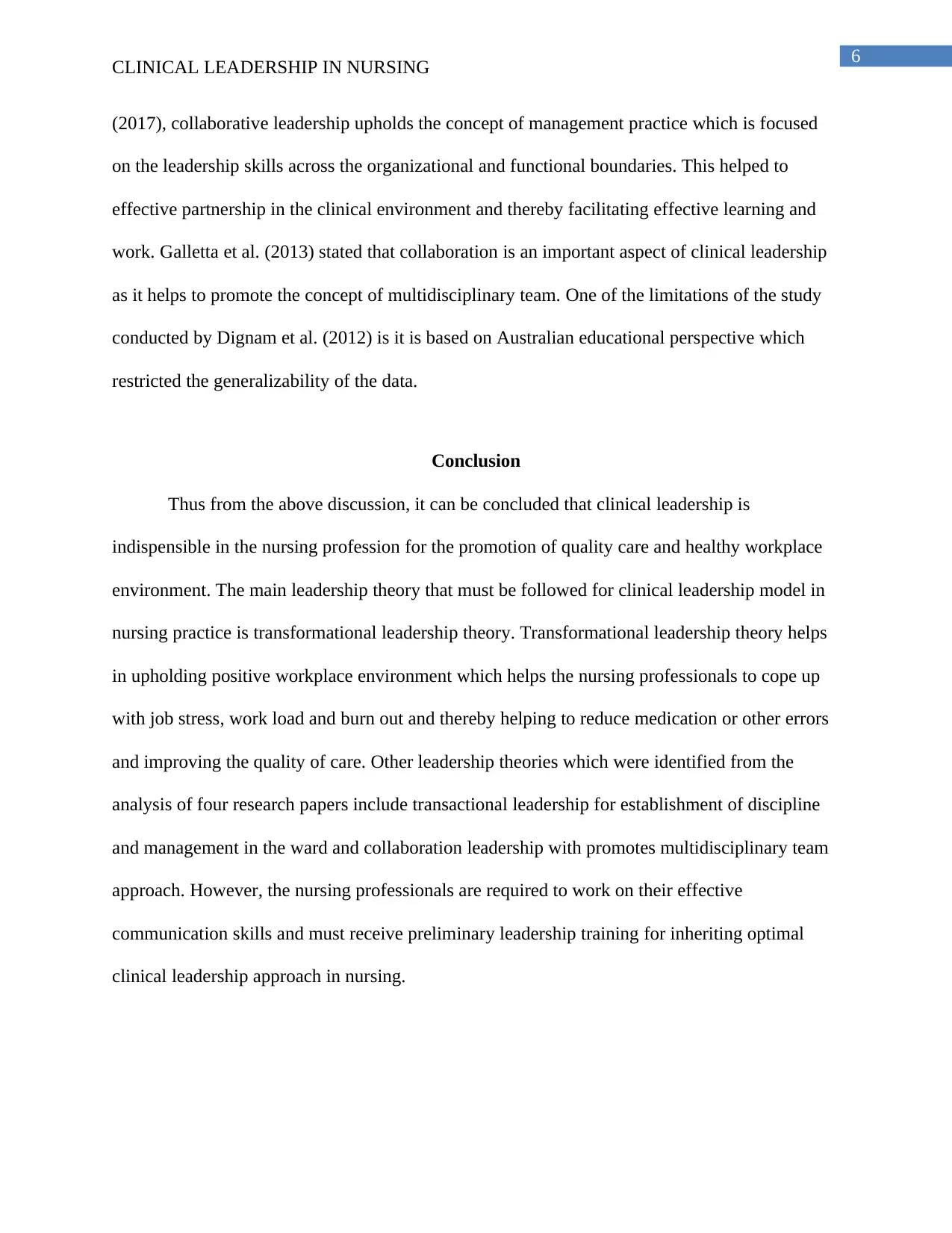
6
CLINICAL LEADERSHIP IN NURSING
(2017), collaborative leadership upholds the concept of management practice which is focused
on the leadership skills across the organizational and functional boundaries. This helped to
effective partnership in the clinical environment and thereby facilitating effective learning and
work. Galletta et al. (2013) stated that collaboration is an important aspect of clinical leadership
as it helps to promote the concept of multidisciplinary team. One of the limitations of the study
conducted by Dignam et al. (2012) is it is based on Australian educational perspective which
restricted the generalizability of the data.
Conclusion
Thus from the above discussion, it can be concluded that clinical leadership is
indispensible in the nursing profession for the promotion of quality care and healthy workplace
environment. The main leadership theory that must be followed for clinical leadership model in
nursing practice is transformational leadership theory. Transformational leadership theory helps
in upholding positive workplace environment which helps the nursing professionals to cope up
with job stress, work load and burn out and thereby helping to reduce medication or other errors
and improving the quality of care. Other leadership theories which were identified from the
analysis of four research papers include transactional leadership for establishment of discipline
and management in the ward and collaboration leadership with promotes multidisciplinary team
approach. However, the nursing professionals are required to work on their effective
communication skills and must receive preliminary leadership training for inheriting optimal
clinical leadership approach in nursing.
CLINICAL LEADERSHIP IN NURSING
(2017), collaborative leadership upholds the concept of management practice which is focused
on the leadership skills across the organizational and functional boundaries. This helped to
effective partnership in the clinical environment and thereby facilitating effective learning and
work. Galletta et al. (2013) stated that collaboration is an important aspect of clinical leadership
as it helps to promote the concept of multidisciplinary team. One of the limitations of the study
conducted by Dignam et al. (2012) is it is based on Australian educational perspective which
restricted the generalizability of the data.
Conclusion
Thus from the above discussion, it can be concluded that clinical leadership is
indispensible in the nursing profession for the promotion of quality care and healthy workplace
environment. The main leadership theory that must be followed for clinical leadership model in
nursing practice is transformational leadership theory. Transformational leadership theory helps
in upholding positive workplace environment which helps the nursing professionals to cope up
with job stress, work load and burn out and thereby helping to reduce medication or other errors
and improving the quality of care. Other leadership theories which were identified from the
analysis of four research papers include transactional leadership for establishment of discipline
and management in the ward and collaboration leadership with promotes multidisciplinary team
approach. However, the nursing professionals are required to work on their effective
communication skills and must receive preliminary leadership training for inheriting optimal
clinical leadership approach in nursing.
Paraphrase This Document
Need a fresh take? Get an instant paraphrase of this document with our AI Paraphraser
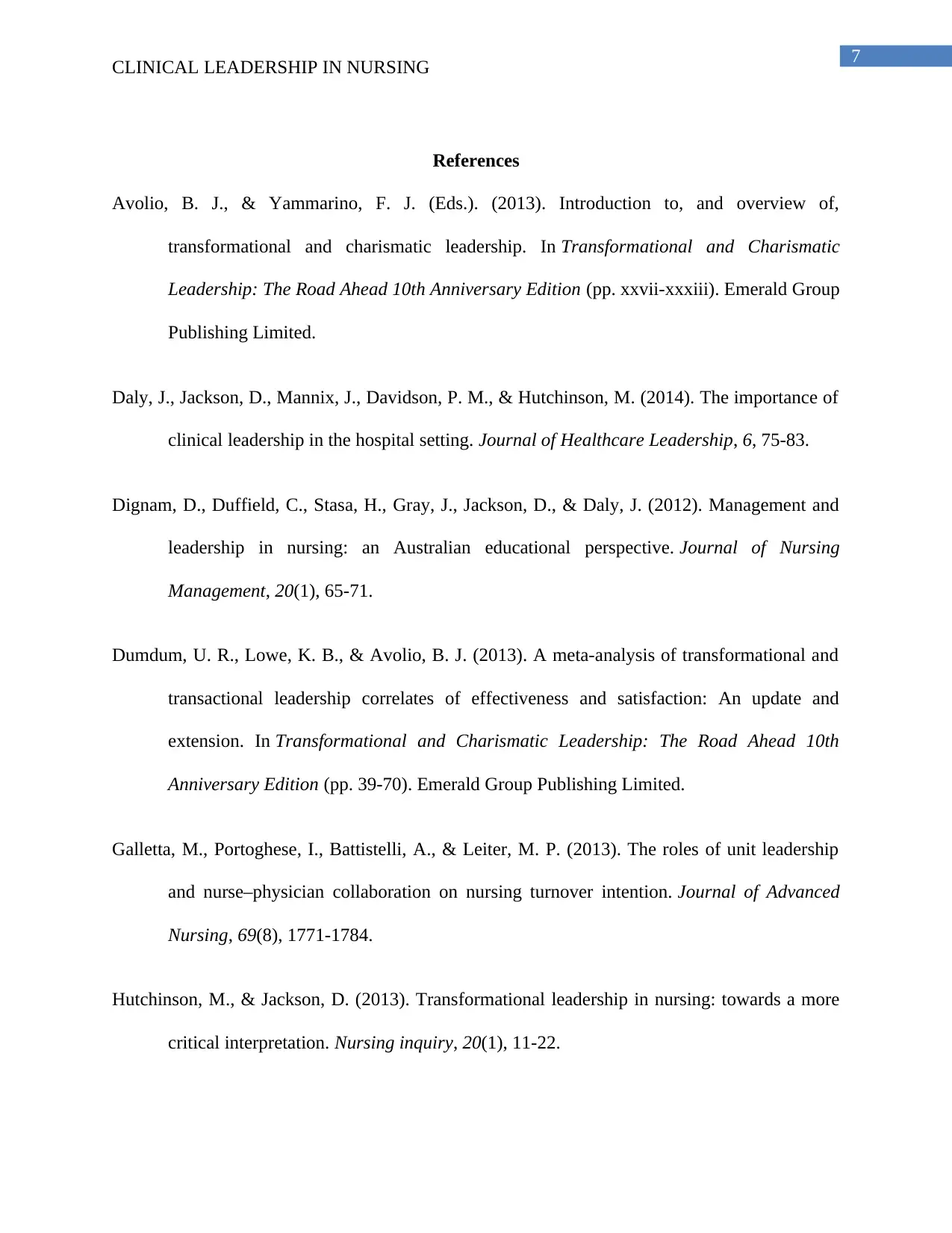
7
CLINICAL LEADERSHIP IN NURSING
References
Avolio, B. J., & Yammarino, F. J. (Eds.). (2013). Introduction to, and overview of,
transformational and charismatic leadership. In Transformational and Charismatic
Leadership: The Road Ahead 10th Anniversary Edition (pp. xxvii-xxxiii). Emerald Group
Publishing Limited.
Daly, J., Jackson, D., Mannix, J., Davidson, P. M., & Hutchinson, M. (2014). The importance of
clinical leadership in the hospital setting. Journal of Healthcare Leadership, 6, 75-83.
Dignam, D., Duffield, C., Stasa, H., Gray, J., Jackson, D., & Daly, J. (2012). Management and
leadership in nursing: an Australian educational perspective. Journal of Nursing
Management, 20(1), 65-71.
Dumdum, U. R., Lowe, K. B., & Avolio, B. J. (2013). A meta-analysis of transformational and
transactional leadership correlates of effectiveness and satisfaction: An update and
extension. In Transformational and Charismatic Leadership: The Road Ahead 10th
Anniversary Edition (pp. 39-70). Emerald Group Publishing Limited.
Galletta, M., Portoghese, I., Battistelli, A., & Leiter, M. P. (2013). The roles of unit leadership
and nurse–physician collaboration on nursing turnover intention. Journal of Advanced
Nursing, 69(8), 1771-1784.
Hutchinson, M., & Jackson, D. (2013). Transformational leadership in nursing: towards a more
critical interpretation. Nursing inquiry, 20(1), 11-22.
CLINICAL LEADERSHIP IN NURSING
References
Avolio, B. J., & Yammarino, F. J. (Eds.). (2013). Introduction to, and overview of,
transformational and charismatic leadership. In Transformational and Charismatic
Leadership: The Road Ahead 10th Anniversary Edition (pp. xxvii-xxxiii). Emerald Group
Publishing Limited.
Daly, J., Jackson, D., Mannix, J., Davidson, P. M., & Hutchinson, M. (2014). The importance of
clinical leadership in the hospital setting. Journal of Healthcare Leadership, 6, 75-83.
Dignam, D., Duffield, C., Stasa, H., Gray, J., Jackson, D., & Daly, J. (2012). Management and
leadership in nursing: an Australian educational perspective. Journal of Nursing
Management, 20(1), 65-71.
Dumdum, U. R., Lowe, K. B., & Avolio, B. J. (2013). A meta-analysis of transformational and
transactional leadership correlates of effectiveness and satisfaction: An update and
extension. In Transformational and Charismatic Leadership: The Road Ahead 10th
Anniversary Edition (pp. 39-70). Emerald Group Publishing Limited.
Galletta, M., Portoghese, I., Battistelli, A., & Leiter, M. P. (2013). The roles of unit leadership
and nurse–physician collaboration on nursing turnover intention. Journal of Advanced
Nursing, 69(8), 1771-1784.
Hutchinson, M., & Jackson, D. (2013). Transformational leadership in nursing: towards a more
critical interpretation. Nursing inquiry, 20(1), 11-22.
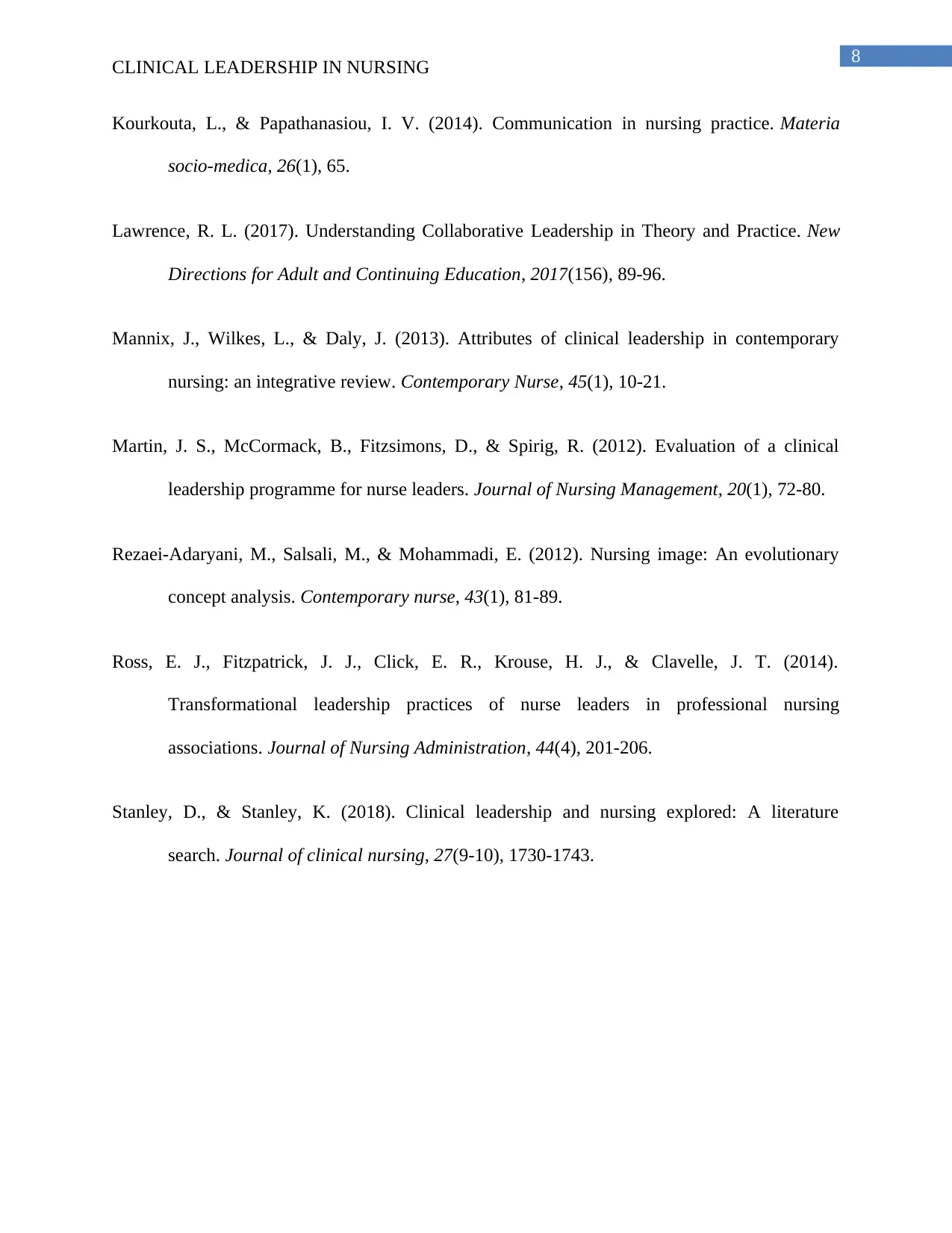
8
CLINICAL LEADERSHIP IN NURSING
Kourkouta, L., & Papathanasiou, I. V. (2014). Communication in nursing practice. Materia
socio-medica, 26(1), 65.
Lawrence, R. L. (2017). Understanding Collaborative Leadership in Theory and Practice. New
Directions for Adult and Continuing Education, 2017(156), 89-96.
Mannix, J., Wilkes, L., & Daly, J. (2013). Attributes of clinical leadership in contemporary
nursing: an integrative review. Contemporary Nurse, 45(1), 10-21.
Martin, J. S., McCormack, B., Fitzsimons, D., & Spirig, R. (2012). Evaluation of a clinical
leadership programme for nurse leaders. Journal of Nursing Management, 20(1), 72-80.
Rezaei-Adaryani, M., Salsali, M., & Mohammadi, E. (2012). Nursing image: An evolutionary
concept analysis. Contemporary nurse, 43(1), 81-89.
Ross, E. J., Fitzpatrick, J. J., Click, E. R., Krouse, H. J., & Clavelle, J. T. (2014).
Transformational leadership practices of nurse leaders in professional nursing
associations. Journal of Nursing Administration, 44(4), 201-206.
Stanley, D., & Stanley, K. (2018). Clinical leadership and nursing explored: A literature
search. Journal of clinical nursing, 27(9-10), 1730-1743.
CLINICAL LEADERSHIP IN NURSING
Kourkouta, L., & Papathanasiou, I. V. (2014). Communication in nursing practice. Materia
socio-medica, 26(1), 65.
Lawrence, R. L. (2017). Understanding Collaborative Leadership in Theory and Practice. New
Directions for Adult and Continuing Education, 2017(156), 89-96.
Mannix, J., Wilkes, L., & Daly, J. (2013). Attributes of clinical leadership in contemporary
nursing: an integrative review. Contemporary Nurse, 45(1), 10-21.
Martin, J. S., McCormack, B., Fitzsimons, D., & Spirig, R. (2012). Evaluation of a clinical
leadership programme for nurse leaders. Journal of Nursing Management, 20(1), 72-80.
Rezaei-Adaryani, M., Salsali, M., & Mohammadi, E. (2012). Nursing image: An evolutionary
concept analysis. Contemporary nurse, 43(1), 81-89.
Ross, E. J., Fitzpatrick, J. J., Click, E. R., Krouse, H. J., & Clavelle, J. T. (2014).
Transformational leadership practices of nurse leaders in professional nursing
associations. Journal of Nursing Administration, 44(4), 201-206.
Stanley, D., & Stanley, K. (2018). Clinical leadership and nursing explored: A literature
search. Journal of clinical nursing, 27(9-10), 1730-1743.
⊘ This is a preview!⊘
Do you want full access?
Subscribe today to unlock all pages.

Trusted by 1+ million students worldwide

9
CLINICAL LEADERSHIP IN NURSING
CLINICAL LEADERSHIP IN NURSING
1 out of 10
Related Documents
Your All-in-One AI-Powered Toolkit for Academic Success.
+13062052269
info@desklib.com
Available 24*7 on WhatsApp / Email
![[object Object]](/_next/static/media/star-bottom.7253800d.svg)
Unlock your academic potential
Copyright © 2020–2025 A2Z Services. All Rights Reserved. Developed and managed by ZUCOL.




